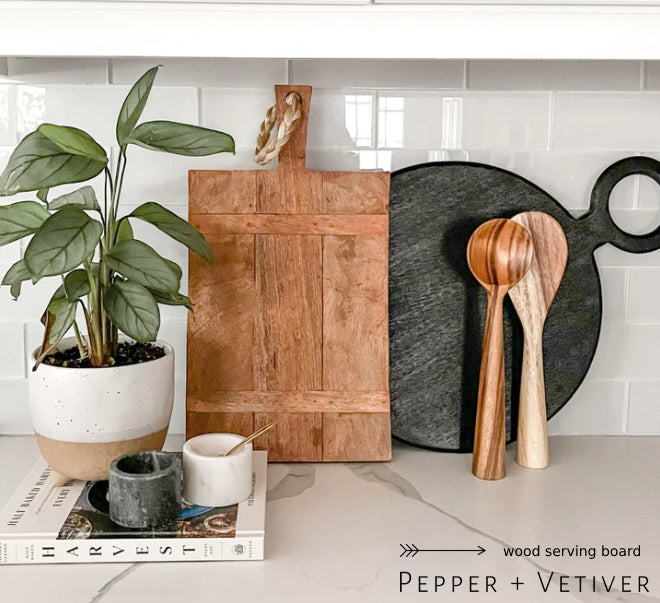Wood cutting boards have long been a staple in kitchens around the world, not just for their utility but also for their beauty. As someone who enjoys cooking and entertaining, I can assure you that a decorative wood cutting board is not just a practical item; it can be a stunning centerpiece to your kitchen. In this article, we’ll delve deeply into the world of decorative wood cutting boards, discussing types, care tips, and how to choose the perfect one for your needs.
Why Choose Decorative Wood Cutting Boards?
There are several reasons why someone might opt for a decorative wood cutting board over a plastic one. Let’s explore some of these key benefits:
- Aesthetics: Decorative wood cutting boards add a touch of elegance to your kitchen and dining table.
- Durability: High-quality wood cutting boards can last for years when maintained properly.
- Knife Friendliness: Wood is gentler on knife blades compared to harder materials, prolonging the life of your knives.
- Bacteria Resistant: Some studies suggest that wood has natural antibacterial properties.
Types of Decorative Wood Cutting Boards
Understanding the types of wood cutting boards available will help you make a more informed decision when purchasing one. They typically fall into three main categories:
1. End Grain Cutting Boards
End grain boards are made by gluing together small blocks of wood in a way that the ends of the wood pieces are exposed. This type provides a unique aesthetic and is extremely durable.

| Pros | Cons |
|---|---|
| Gentle on knives | Generally more expensive |
| Self-healing properties | Heavy and may require extra care |
2. Edge Grain Cutting Boards
Edge grain boards are made from strips of wood that are glued together with the long edge facing up. These boards are more affordable and lighter than end grain boards.

| Pros | Cons |
|---|---|
| More affordable | Less forgiving on knife blades |
| Lightweight | Can show knife scars over time |
3. Flat Grain Cutting Boards
Flat grain boards are made from whole planks of wood. They offer a classic look and usually come at a lower price point.

| Pros | Cons |
|---|---|
| Classic aesthetic | Less durable |
| Lower price point | Prone to warping |
Materials Used in Decorative Wood Cutting Boards
Different types of wood provide unique aesthetics and functionalities. Here are some popular choices:

1. Maple
Hard maple is a popular choice for cutting boards due to its durability and resistance to scratches.
2. Walnut
Walnut boards offer rich, dark hues and a premium feel. They are highly durable and aesthetically pleasing.

3. Bamboo
Bamboo cutting boards are eco-friendly and lightweight, although they can be harder on knives.
How to Choose the Perfect Decorative Wood Cutting Board
Selecting the right board involves considering your personal needs and preferences. Here’s a guide to help you out:

1. Size Matters
Determine what size will work best in your kitchen. If you cook frequently or prep large meals, choose a larger board.
2. Weight and Portability
Heavier boards can offer stability, but if you need to store your cutting board away, consider a lighter option.

3. Grain Type and Design
Choose a board with a design that complements your kitchen décor. End grain boards, for instance, have unique patterns that can serve as décor.
Care Tips for Decorative Wood Cutting Boards
Maintaining the beauty and longevity of your wood cutting board requires proper care:
1. Cleaning
After each use, wash your cutting board with warm, soapy water. Avoid soaking it in water to prevent warping.
2. Oiling
Regularly oil your board with food-grade mineral oil to maintain its sheen and prevent drying out.
3. Avoid Dishwashers
Never place your wooden cutting board in the dishwasher, as the heat and moisture can damage it.
Decorative Wood Cutting Boards for Entertaining
A decorative wood cutting board can also double as a serving platter for your charcuterie boards or cheese displays. Here are some tips:
1. Choose a Large Board
A larger board provides ample space for various meats, cheeses, and accompaniments, making your spread more visually appealing.
2. Layering
Layer different food items, utilizing heights for a visually striking presentation.
3. Personal Touches
Incorporate personal touches, such as small herbs or edible flowers, to elevate your presentation.
Pros and Cons of Decorative Wood Cutting Boards
Pros
- Stylish kitchen accessory
- Natural aesthetic appeal
- Durable with proper care
- Keeps knives sharper longer
Cons
- Higher initial investment
- Requires regular maintenance
- Can be heavier than alternatives
FAQs about Decorative Wood Cutting Boards
Q1: Are wood cutting boards better than plastic?
A1: While both have their benefits, many chefs prefer wood for its aesthetics, knife-friendliness, and natural antibacterial properties.
Q2: How often should I oil my wood cutting board?
A2: Ideally, you should oil your cutting board every month or whenever it looks dry.
Q3: Can I use both sides of my cutting board?
A3: Yes, but it’s wise to designate one side for raw meats and the other for vegetables or cooked foods to avoid cross-contamination.
Q4: What’s the best way to remove odor from my cutting board?
A4: Scrub your board with a mixture of lemon juice and coarse salt, then rinse and dry it thoroughly.
Conclusion
Decorative wood cutting boards carry not just functionality but artistry into your kitchen. Whether you’re chopping vegetables, serving charcuterie, or looking for a stylish piece to elevate your kitchen décor, these boards serve many purposes. By understanding the different types, materials, and care required, you can choose a cutting board that not only meets your culinary needs but also enhances your kitchen’s aesthetic.
As you consider your options, remember that a quality decorative wood cutting board can become a cherished heirloom, passed down through generations, symbolizing the love for cooking and family gatherings. Embrace the beauty and functionality of decorative wood cutting boards, and let your kitchen shine!